
Electronic Health Records (EHR) are at the core of modern healthcare delivery. They organize and store patient information, manage workflows, support billing, and increasingly serve as the primary interface between providers and patients. Given this central role, it’s no surprise that many healthcare organizations eventually find themselves facing a critical question: Should we build our own EHR, or buy an existing one?
This question has been gaining more attention, and Christina Farr recently explored it in a compelling piece on her blog Second Opinion. Farr highlights the high costs, complexity, and opportunity cost involved in building a custom EHR, particularly referencing the experiences of major health systems like Epic customers who have thought about building but often stick with commercial solutions due to the immense scope of such projects.
Yet, dissatisfaction with existing EHRs remains a common complaint in the industry. Clinicians often feel that the tools they use daily are clunky, inefficient, or missing essential functionality. This frustration can spark the idea that perhaps the solution is to start over, to build a “better EHR.”
But before going all-in on a massive build, it’s worth taking a closer look at what’s really broken.
It’s Usually Not the EHR That Needs Replacing
One of the most common reasons healthcare organizations become frustrated with their EHRs is poor patient access functionality. Patients might struggle to book appointments, access their records, communicate with clinicians, or handle billing in a way that feels intuitive and convenient.
This has led some organizations to consider scrapping their existing EHR in pursuit of something that meets patient experience expectations. However, in many cases, the clinical and administrative backbone of the EHR is functional, it’s just the patient-facing layer that falls short.
That layer can be decoupled.
Rather than rebuilding the entire EHR stack from scratch, organizations can opt to integrate a modern, standalone patient access solution that works with their current EHR. This approach not only preserves the heavy investment already made in existing EHR infrastructure, but also accelerates time-to-value by allowing rapid improvement in patient experience.
Integration is the New Differentiation
Modern patient access platforms are designed to integrate with a variety of EHR systems. They act as modular add-ons that deliver the functionality patients expect – appointment scheduling, messaging, telehealth, digital intake, and records access, without requiring a total overhaul of the underlying system.
This kind of modular approach lets healthcare organizations evolve their digital front doors without compromising the foundational clinical systems that keep operations running. For instance, some patient access solutions, such as Healee, are designed to integrate with a variety of EHR platforms, including open source systems like Medplum. This demonstrates how existing technologies can complement one another rather than requiring a full rebuild.
The Case for Open Source: Building with Medplum
Still, some organizations may conclude that their workflows, specialties, or models of care are simply too unique for any off-the-shelf EHR. They may need customization and control that only building can provide.
If that’s the case, it doesn’t mean they need to build everything from the ground up. Open source EHR frameworks like Medplum offer a compelling middle ground.
Medplum is a headless, FHIR-native EHR designed to be highly extensible and developer-friendly. It provides the foundational infrastructure – FHIR APIs, authentication, audit logs, and a backend designed for interoperability, so teams can focus on building the interfaces and workflows that matter most to them.
With Medplum, healthcare organizations can:
- Retain control over data and user experience
- Avoid vendor lock-in
- Customize workflows and interfaces for specific clinical or operational needs
- Start building faster by leveraging robust technical architecture that’s already in place
Even better, patient access tools like Healee can integrate with platforms such as Medplum, enabling organizations to combine custom clinical systems with user-friendly, patient-facing features.
Think Modular, Not Monolithic
The monolithic EHR era is giving way to a more modular future. Instead of choosing between full custom builds and one-size-fits-all platforms, healthcare organizations now have options that let them mix and match components to create systems tailored to their needs.
This modular strategy not only reduces risk and cost, it also supports faster innovation. A hospital can upgrade its patient portal without disturbing clinical workflows. A specialty clinic can add unique care coordination features while keeping standard EHR functionality intact.
By thinking in terms of composable systems rather than monolithic platforms, healthcare organizations can be more agile and better serve both clinicians and patients.
Conclusion
The decision to build or buy an EHR is complex, with significant implications for budget, timeline, and organizational focus. While it might be tempting to embark on a custom build when frustrations with existing systems mount, it’s important to first ask: What part of the system is truly broken?
In most cases, the answer lies not in the core clinical infrastructure, but in the patient experience layer. And the good news is that this layer can often be replaced independently.
Platforms like Healee provide a modern, customizable patient access interface that can work with existing EHRs or new platforms like Medplum. And for those who do need deep customization, open source solutions like Medplum provide a head start that makes building more feasible.
Rather than going all in on a full rebuild, organizations should consider modular strategies that let them innovate where it matters most while preserving what already works.
In the end, the question isn’t simply whether to build or buy. It’s how to build smarter, with the right tools, integrations, and strategy for your unique needs.
